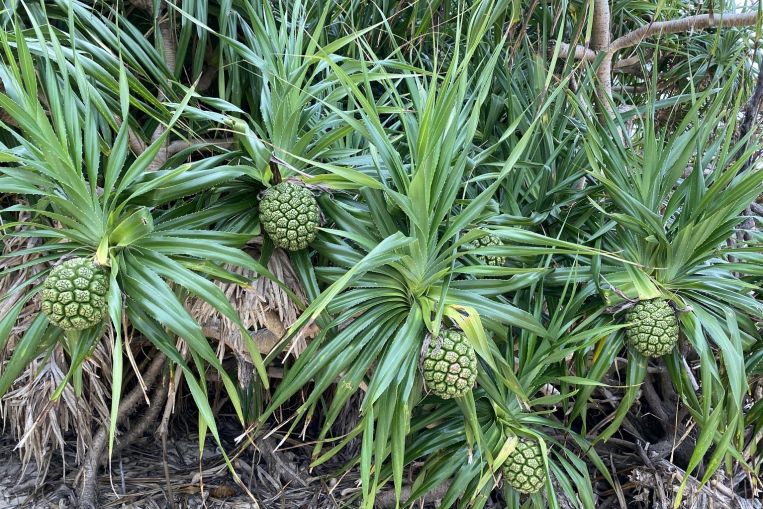Plant is the Thatch Screwpine or Seashore Pandan
During my holiday in Okinawa, I came across these fruit that looked like pineapples. Is it a kind of pineapple? Can it be eaten? What is the name of this plant?
Shannen Soo
The plant is likely a species of tree pandan, called the Thatch Screwpine or Seashore pandan (botanical name: Pandanus tectorius).
It exhibits a unique growth habit where it produces prop roots that provide support for the plant.
The globose structures borne on the plant are clusters of fruit which are edible when ripe.
This plant is often grown as an ornamental plant in Singapore for its architectural growth habit, but it must be situated away from human traffic due to the numerous sharp spines found on the edge of its leaves.
Ants on chilli plants, leaves of basil changing colour and hardy hibiscus showing sign of iron deficiency
I have several plants that seem to need help. My chilli plants (photo 1) have red ants on the stems, but they do not seem to disturb the fruit. How can I get rid of them? For my Thai basil (photo 2), some of its leaves have changed colour and dried up. What is the reason for this and how can I prevent this from happening again? Finally, the leaves on my hibiscus plant (photo 3) have been turning whitish yellow in the last few months. It happened after I moved the pot in and out of my balcony over a week due to painting works. My balcony gets the morning sun.
Melissa Tan
When you see ants on your chilli plant, check for the presence of sap-sucking pests such as aphids, mealybugs and scale insects.
These pests produce honeydew, a sugar-rich waste that attracts ants. You may want to reduce the population of these pests for a start.
Your Thai basil leaves appear to have brown leaf edges, which may be a sign of burns caused by application of a fertiliser or pesticide. Before spraying any chemical on the plant, test it on a small part before spraying the entire plant to reduce the likelihood of injuring it.
Another cause could be fungal disease or sucking insects such as lace bugs. The likelihood of fungal diseases can be reduced by growing the plant in a location with good light and ample air circulation. Prune diseased leaves to minimise the spread of the disease.
Sap-sucking insects can cause leaf tissue to be damaged and die. Check for lacebugs, which are common pests for basil plants. They can be effectively removed by using a chemical pesticide such as cypermethrin.
As for your hibiscus plant, it has chlorotic leaves that indicate it is suffering from iron deficiency, an issue very common in Singapore. The common cases include alkaline soil as well as compacted and poorly drained soil.
It is best that you check the pH level of your soil using a soil pH test kit. Alkaline soil can be corrected with the addition of sulphur. Good quality organic matter can also be added to help improve drainage and aeration in the soil for healthy roots.
You can also give water-soluble fertilisers that have chelated iron for easier absorption by the plant.
Mother of Thousands is toxic to animals and can become a weed
May I know the name of this succulent?
Tham Lai Pui
The succulent is commonly known as Mother of Thousands and its botanical name is Kalanchoe laetivirens.
Its common name is derived from the plant’s ability to produce numerous small plantlets on the edge of the leaves.
The plant can become weedy and plantlets can grow in places where they are not wanted.
It grows best in a well-drained media and when it is exposed to at least four hours of direct sunlight. Keep it away from dogs and cats as it is toxic to the animals if ingested.
• Answers by Dr Wilson Wong, an NParks-certified practising horticulturist, parks manager and ISA-certified arborist. He is the founder of Green Culture Singapore and an adjunct assistant professor (Food Science & Technology) at the National University of Singapore.
• Have a gardening query? E-mail it with clear, high-resolution pictures of at least 1MB, if any, and your full name to [email protected]. We reserve the right to edit and reject questions.
Source: Read Full Article
